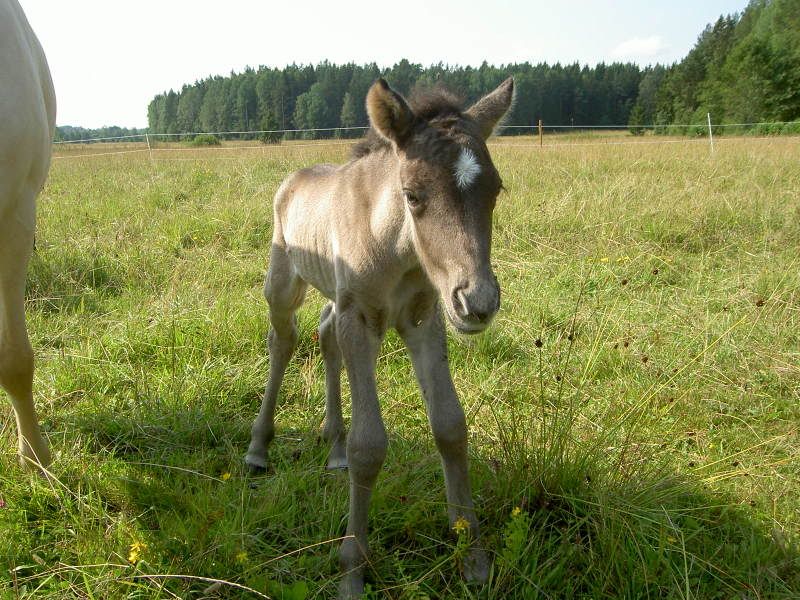"It is theorized that there are three different types of agouti. "A" is the Agouti which causes "regular" bay; "A+" is the "wild type" Agouti, which results in a light bay horse with very little black on the legs, usually just around the fetlocks; and "At" is brown, or what is sometimes called "seal brown", a nearly black horse with reddish areas on the muzzle and flanks. A horse will have some combination of the three types, one of the three types plus one non-agouti gene (one non-agouti gene is written as "a"), or have no agouti at all ("aa").
Evidence suggests that there is an order of dominance amongst the various agoutis, with wild bay (the most restrictive of black) being dominant to bay, and bay being dominant to brown (the least restrictive of black). If this is true, two browns could not produce a bay. Also, if a horse has one bay and one wild bay gene, he'll be wild bay; if he has one brown and one bay he'll be bay; but he'll need two brown genes or one brown, one "no agouti" (a) to be brown at all.
There is a lot of crossover in phenotype (appearance) between very dark bays and browns. At this time there is no way to distinguish which of the three types of agoutis a horse has when color testing. The difference between the two may just be a matter of shade, just as other colors have a vast range of shades from very light to very dark." Från
http://colormorgans.tripod.com/basecolors.htm
"Seal brown horses are actually caused by the Agouti gene, too, but are considered a different color than bay,
because the gene is a different allele than that which causes regular bay (although some breed registries lump seal brown in with bay)."
Från:
http://www.ultimatehorsesite.com/colors/bay.html
"The "A" gene (Agouti) restricts black (which would otherwise cover the entire horse) to the "points," leaving the body red.
Agouti has no effect on a Red base coat, since Red has no black to restrict. Agouti can be carried by a red horse, however, and transmitted to offspring. Thus, a red and a black horse can produce bay offspring if the red horse carries Agouti.
University of California, Davis, began in 2003 to offer a test for Agouti (Bay/Black).
You can download forms for this and other tests from their website-- follow
the links from
http://www.vgl.ucdavis.edu
Wild-Type Bay ("A+")
Some geneticists, including Sponenberg, contend that a third allele is possible at the Agouti locus. It is denoted as "A+" and is called "Wild Type Bay."
The Wild-Type allele A+ expresses itself in that the points (particularly the lower legs) tend to have less black than regular bay color. The black portions of the cannon and lower leg are mixed with (sometimes very diluted appearing light golden) red pigmentation rather than being solid black.
Wild Type Bay also refers to an effect that mimics, and may also be partially caused by, the Pangare/Mealy gene, with the muzzle, underside, flanks, and behind the elbow lightened.
Angelo, a "Wild-Type Bay" brown horse.Wild-Type Bay is, not surprisingly, fairly common in wild horses - but is in no way restricted to them.
NEWS FLASH!!!
Preliminary testing by a laboratory in France indicates that a form of the AGOUTI gene ("A+" or "Wild Type Bay") may be the agent that creates the Seal Brown pattern, which has up until now been attributed to the Pangare gene working on a Black base.
Apparently, all Seal Browns so far have tested by the French lab are positive for Agouti, indicating that they are perhaps a form of very dark, sooty Wild Type Bay.
-from "The Horse" Second Addition. Authors J. Warren Evans, Anthony Borton, Harold F. Hintz, L. Dale Van Vleck.
Copyrighted 1990. On page 479-481.
However, if you breed 2 Seal Browns you don't necessarily get a Bay, which indicates that more research is needed.
- Thanks to Joycelyn Kasmir
www.DiamondJFarms.com for this information!"
Från:
http://www.mustangs4us.com/Horse Colors/agouti.htm
"The allele At is dominant over Aa, but recessive to the other alleles of the agouti series. Horses of genotypes AtAt or AtAa are brown. Their soft parts, such as the muzzle and eyebrows, and around the flanks, quarters and girth, are changed to red or yellow (“mealy”). Their bodies may remain black (as in seal browns) or be shaded black and brown. Brown horses can therefore look all shades from light brown to almost black. "
Från:
http://www.horse-genetics.com/horse-color-genetics.html
 Som sagt, creme är där nog. Är hon ljusare runt ögon och mule, samt ljumskar? Då är hon hon gulbrun, är det däremot samma färg som resten av kroppen så tippar vi på gulsvart. Här är min gulsvarta lady, btw.
Som sagt, creme är där nog. Är hon ljusare runt ögon och mule, samt ljumskar? Då är hon hon gulbrun, är det däremot samma färg som resten av kroppen så tippar vi på gulsvart. Här är min gulsvarta lady, btw.




